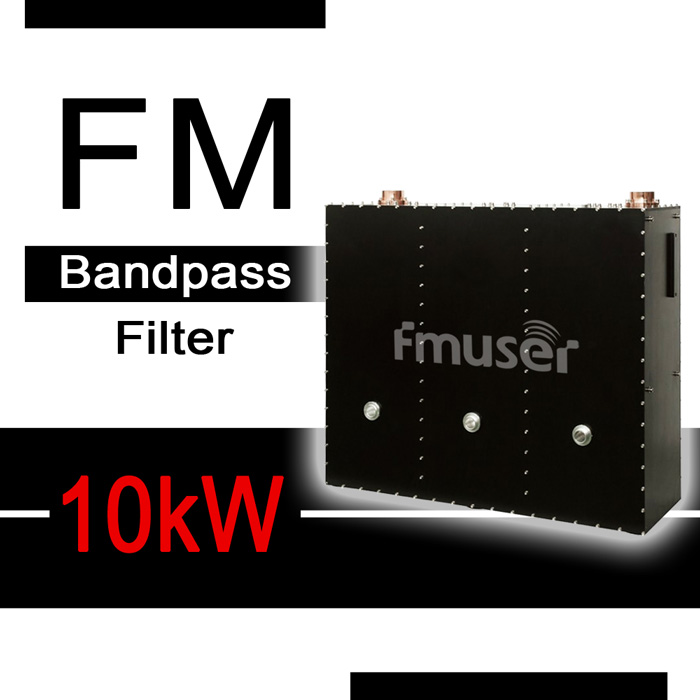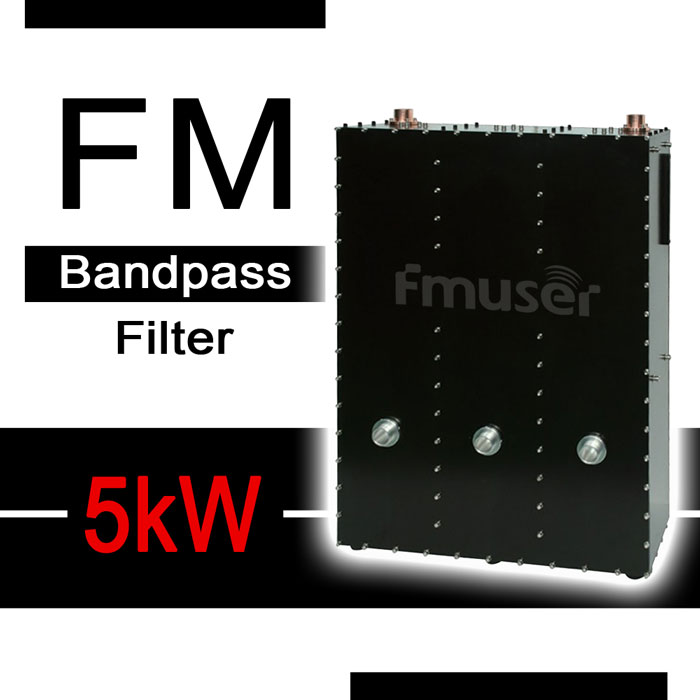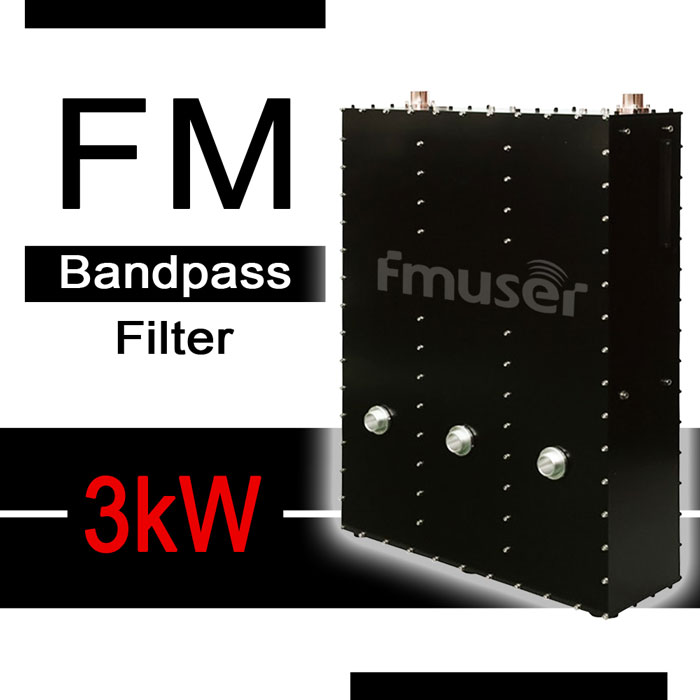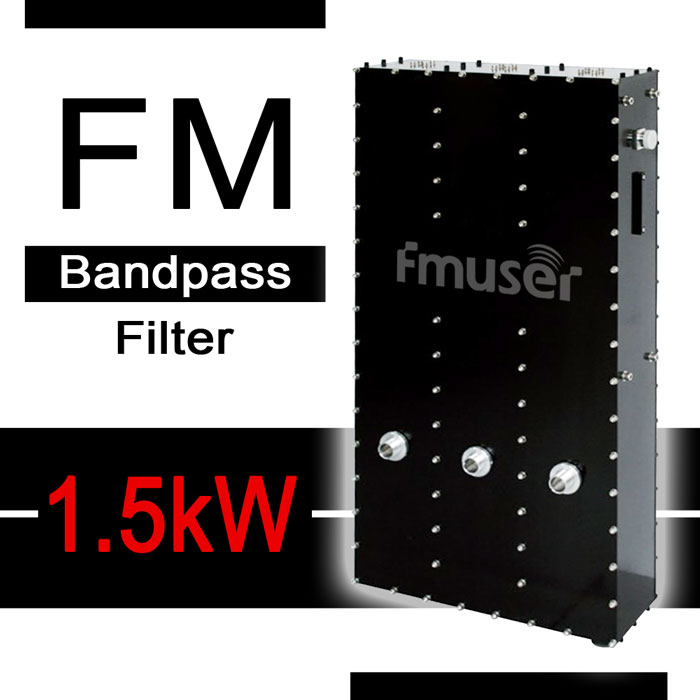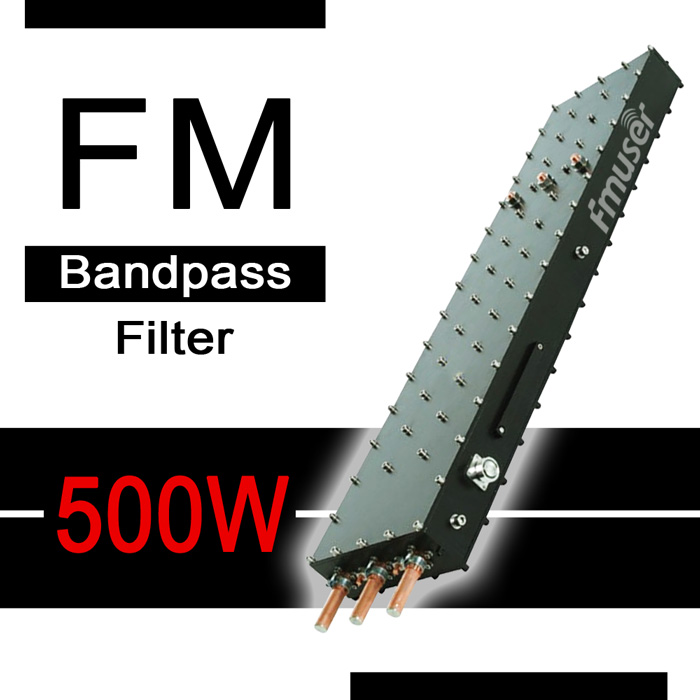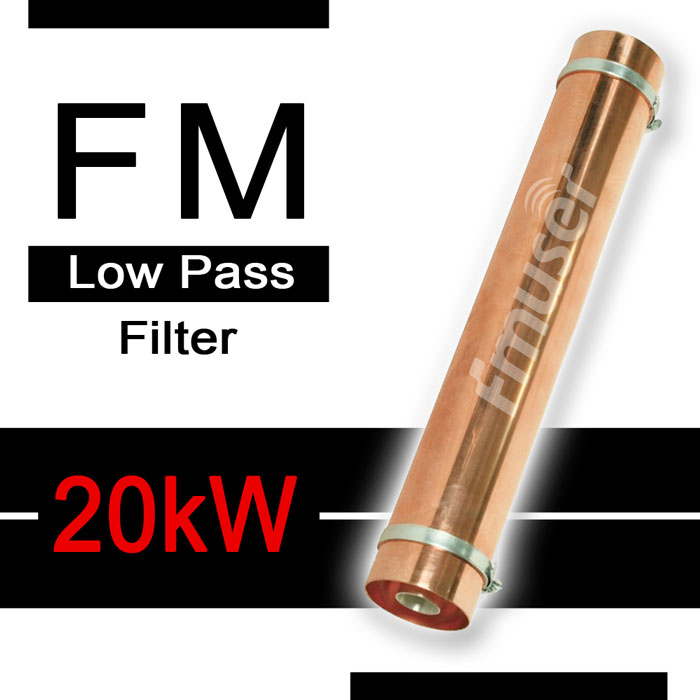
Filtru tal-Kavità FM
Filtru tal-Kavità FM huwa tip ta 'filtru użat fl-istazzjonijiet tax-xandir FM biex jimminimizza l-interferenza bejn frekwenzi differenti. Jaħdem billi jippermetti biss li tgħaddi l-frekwenza mixtieqa u timblokka frekwenzi oħra. Dan huwa importanti għax-xandir tar-radju FM, peress li jgħin biex jipprevjeni interferenza minn stazzjonijiet tar-radju oħra fil-qrib, inaqqas l-istorbju, u jżomm is-saħħa tas-sinjal. Sabiex tuża FM Cavity Filter fi stazzjon tax-xandir FM, għandu jkun installat bejn it-trasmettitur u l-antenna. Dan jiżgura li jintbagħtu biss il-frekwenzi li x-xandar jixtieq jittrasmetti.
-
![FMUSER 87-108MHz 10000W FM Bandpass Filter 10kW FM Band Pass Filter With Custom Bandwidth for Transmitter System]()
Prezz (USD): Itlob għal kwotazzjoni
Mibjugħa: 18
-
![FMUSER 87-108MHz 5000W FM Bandpass Filter 5kW FM Band Pass Filter With Coaxial Cavities for FM Radio Antenna System]()
Prezz (USD): Itlob għal kwotazzjoni
Mibjugħa: 17
-
![FMUSER 87-108MHz 3000W FM Bandpass Filter 3kW FM Band Pass Filter With Tuneable Frequency for FM Radio Antenna System]()
Prezz (USD): Itlob għal kwotazzjoni
Mibjugħa: 24
-
![FMUSER 87-108MHz 1500W FM Bandpass Filter 1.5kW FM Band Pass Filter With Tuneable Frequency for FM Radio Station]()
Prezz (USD): Itlob għal kwotazzjoni
Mibjugħa: 35
-
![FMUSER 500W FM Bandpass Filter Low VSWR 87-108MHz Frequency Tuneable FM Band Pass Filter for TX RF System]()
Prezz (USD): Itlob għal kwotazzjoni
Mibjugħa: 15
-
![20kW FM Low Pass Filter 87-108 MHz FM Broadcast Low Pass Filter for FM Transmitter and Broadcast Stations]()
Prezz (USD): Ikkuntattjana
Mibjugħa: 51
- X'inhu l-Filtru tal-Kavità FM?
- Filtru tal-Kavità FM huwa apparat elettroniku li jintuża biex jiffiltra sinjali mhux mixtieqa minn medda ta 'frekwenza. Huwa magħruf ukoll bħala filtru band-pass. Jaħdem billi jippermetti li jgħaddu biss sinjali f'ċerta firxa ta' frekwenza filwaqt li tirrifjuta l-frekwenzi l-oħra kollha. Huwa komunement użat fis-sistemi ta 'komunikazzjoni bir-radju biex titnaqqas l-interferenza.
- X'inhuma l-applikazzjonijiet ta 'FM Cavity Filter?
- Il-Filtri tal-Kavità FM jintużaw f'firxa wiesgħa ta 'applikazzjonijiet, inklużi xandir bir-radju u televiżjoni, komunikazzjonijiet ċellulari, Wi-Fi u bis-satellita, sistemi ta' navigazzjoni u GPS, komunikazzjonijiet tar-radar u militari, u applikazzjonijiet industrijali. L-aktar applikazzjonijiet komuni jinkludu:
1. Xandira bir-radju u t-televiżjoni: FM Cavity Filters jintużaw biex inaqqsu l-interferenza bejn l-istazzjonijiet u jottimizzaw ir-riċeviment ta 'stazzjon partikolari.
2. Komunikazzjonijiet ċellulari, Wi-Fi u bis-satellita: FM Cavity Filters jintużaw biex inaqqsu l-interferenza bejn is-sinjali mingħajr fili u jipprevjenu interferenza bejn in-netwerks mingħajr fili.
3. Sistemi ta 'navigazzjoni u GPS: Filtri tal-Kavità FM jintużaw biex inaqqsu l-interferenza bejn is-sinjali tal-GPS u jottimizzaw l-eżattezza ta' sistema partikolari.
4. Radar u komunikazzjonijiet militari: Filtri tal-Kavità FM jintużaw biex inaqqsu l-interferenza bejn is-sinjali u jottimizzaw il-prestazzjoni ta 'sistema partikolari.
5. Applikazzjonijiet industrijali: FM Cavity Filters jintużaw biex inaqqsu l-interferenza bejn is-sinjali u jottimizzaw il-prestazzjoni ta 'sistema industrijali partikolari.
- Kif tuża b'mod korrett FM Cavity Filter fl-istazzjon tax-xandir?
- 1. Ikkalkula l-ammont ta 'filtrazzjoni meħtieġ qabel l-installazzjoni tal-filtru tal-kavità. Dan għandu jinkludi l-ammont ta 'enerġija li qed tintuża, l-ammont ta' attenwazzjoni meħtieġa, u l-ammont aċċettabbli ta 'telf ta' inserzjoni.
2. Agħżel it-tip xieraq ta 'filtru. Dan jista' jinkludi filtri low-pass, high-pass, talja jew bandpass, skont l-applikazzjoni.
3. Immonta l-filtru b'mod sikur fil-linja tat-trasmettitur, filwaqt li tiżgura li jinżamm l-ammont xieraq ta 'iżolament bejn it-trasmettitur u l-antenna.
4. Kun żgur li l-filtru huwa sintonizzat sew għall-frekwenza mixtieqa. Dan jinkludi l-użu ta’ analizzatur tal-ispettru biex jiġi żgurat li l-filtru jiġi aġġustat sew.
5. Immonitorja l-output tal-filtru billi tuża analizzatur tal-ispettru jew miter tal-qawwa tal-kamp. Dan jgħin biex jidentifika kwalunkwe problema potenzjali bil-filtru bħal attenwazzjoni żejda jew baxxa.
6. Kun żgur li l-filtru jiġi spezzjonat u miżmum regolarment. Dan jinkludi t-tindif u s-sostituzzjoni ta 'kwalunkwe komponenti milbus.
7. Evita li tpoġġi wisq qawwa mill-filtru jew tużah bi frekwenza barra mill-firxa maħsuba tiegħu. Dan jista 'jirriżulta f'telf ta' inserzjoni eċċessiv jew saħansitra ħsara lill-filtru.
- Kif jaħdem FM Cavity Filter fl-istazzjon tax-xandir?
- Filtru tal-kavità FM huwa komponent importanti tas-sistema tal-frekwenza tar-radju (RF) ta 'stazzjon tax-xandir. Jintuża biex iżola t-trasmettitur mil-linja ta 'l-għalf ta' l-antenna, u jipprevjeni kwalunkwe sinjal mhux mixtieq milli jilħaq l-antenna. Il-filtru huwa ċirkwit sintonizzat li jikkonsisti f'żewġ reżonaturi tal-kavità jew aktar, kull wieħed sintonizzat għall-frekwenza tal-kanal mixtieqa. Il-kavitajiet huma konnessi flimkien f'serje, li jiffurmaw ċirkwit wieħed. Hekk kif sinjal jgħaddi mill-filtru, il-kavitajiet jirrisonaw fil-frekwenza mixtieqa u jirrifjutaw il-frekwenzi l-oħra kollha. Il-kavitajiet jaġixxu wkoll bħala filtru low-pass, li jippermettu li jgħaddu biss sinjali taħt il-frekwenza mixtieqa. Dan jgħin biex titnaqqas l-interferenza minn sinjali oħra li jistgħu jkunu preżenti fiż-żona.
- Għaliex FM Cavity Filter huwa importanti u huwa meħtieġ għal stazzjon tax-xandir?
- Il-filtri tal-kavità FM huma komponenti essenzjali ta 'kwalunkwe stazzjon tax-xandir, peress li jippermettu lill-istazzjon jikkontrolla l-wisa' tal-frekwenza tas-sinjal li qed jiġi trażmess. Dan jgħin biex tiġi minimizzata l-interferenza u jiġi żgurat li s-sinjal li qed jixxandar ikun ċar u konsistenti kemm jista’ jkun. Billi jikkontrolla l-bandwidth, il-filtru jgħin ukoll biex jiżgura li s-sinjal tax-xandir jilħaq il-livell ta 'qawwa meħtieġ u l-proporzjon tas-sinjal għall-ħoss. Dan jgħin biex itejjeb il-kwalità tas-sinjal tax-xandir u jiżgura li jilħaq l-udjenza maħsuba.
- Kemm hemm tipi ta 'Filtru tal-Kavità FM? X'inhi d-differenza?
- Hemm erba 'tipi ewlenin ta' filtri tal-kavità FM: Notch, Bandpass, Bandstop, u Combline. Filtri Notch huma użati biex jrażżnu frekwenza waħda, filwaqt li filtri Bandpass huma użati biex jgħaddu firxa ta 'frekwenzi. Il-filtri Bandstop jintużaw biex jirrifjutaw firxa ta 'frekwenzi, u l-filtri Combline jintużaw għal applikazzjonijiet ta' Q għoli u ta 'telf baxx.
- Kif tikkonnettja b'mod korrett FM Cavity Filter fi stazzjon tax-xandir?
- 1. Ibda billi skonnettja l-input ta 'l-antenna mit-trasmettitur, u qabbadha mal-Filtru tal-Kavità FM.
2. Qabbad l-output tal-Filtru tal-Kavità FM mal-input tal-antenna tat-trasmettitur.
3. Qabbad is-sors tal-enerġija mal-Filtru tal-Kavità FM.
4. Issettja l-firxa tal-frekwenza tal-filtru biex taqbel mal-frekwenza tat-trasmettitur.
5. Aġġusta l-qligħ u l-bandwidth tal-filtru biex jaqblu mar-rekwiżiti tat-trasmettitur.
6. Ittestja s-setup biex tiżgura li qed taħdem sew.
- Qabel ma tagħmel ordni finali, kif tagħżel l-aħjar FM Cavity Filter għal stazzjon tax-xandir?
- 1. Iddetermina l-firxa tal-frekwenza u r-rekwiżiti tal-enerġija: Qabel ma tagħżel filtru, iddetermina l-firxa tal-frekwenza u r-rekwiżiti tal-qawwa tal-istazzjon tax-xandir. Dan jgħin biex jonqos l-għażliet tal-filtru.
2. Ikkunsidra t-tip ta 'filtru: Hemm żewġ tipi ewlenin ta' filtri - low-pass u high-pass. Filtri low-pass jintużaw biex inaqqsu l-interferenza minn sinjali li huma ogħla mill-frekwenza mixtieqa, filwaqt li filtri high-pass jintużaw biex inaqqsu l-interferenza minn sinjali li huma aktar baxxi mill-frekwenza mixtieqa.
3. Iċċekkja l-ispeċifikazzjonijiet tal-filtru: Ladarba jkun ġie determinat it-tip tal-filtru, iċċekkja l-ispeċifikazzjonijiet tal-filtru biex tiżgura li se tissodisfa r-rekwiżiti tal-enerġija tal-istazzjon tax-xandir.
4. Qabbel il-prezzijiet: Qabbel il-prezzijiet ta 'diversi mudelli ta' filtri biex tiżgura li qed tieħu l-aħjar valur għal flusek.
5. Aqra reviżjonijiet tal-klijenti: Aqra reviżjonijiet tal-klijenti biex ikollok idea tal-prestazzjoni u l-affidabbiltà tal-filtru.
6. Ikkuntattja lill-manifattur: Jekk għandek xi mistoqsijiet dwar il-filtru, ikkuntattja lill-manifattur għal aktar informazzjoni.
- X'inhuma t-tagħmir relatat ma 'FM Cavity Filter fi stazzjon tax-xandir?
- 1. Djar tal-filtru tal-kavità
2. Mutur tal-irfinar tal-filtru
3. Filtri tal-kavità
4. Kontrollur tal-filtru tal-kavità
5. Provvista ta 'enerġija tal-irfinar tal-filtru
6. Transformer ta 'iżolament
7. Kapaċitatur tal-irfinar tal-filtru
8. Filtri low pass
9. High pass filtri
10. Filtri tal-band pass
11. Filtri ta 'waqfien tal-banda
12. Akkoppjar tal-antenna
13. Komponenti ta 'short-circuit li jiżżerżqu
14. Swiċċijiet RF
15. Attenwaturi RF
16. Ġeneratur tas-sinjal
17. Analizzatur tal-ispettru
18. Komponenti tas-sistema tal-antenna
19. Amplifikaturi
- X'inhuma l-aktar speċifikazzjonijiet tekniċi importanti tal-Filtru tal-Kavità FM?
- L-aktar speċifikazzjonijiet fiżiċi u RF importanti tal-filtri tal-kavità FM jinkludu:
fiżika:
-Tip ta 'filtru (Bandpass, Notch, eċċ.)
-Daqs tal-kavità
-Tip ta 'konnettur
-Tip ta 'immuntar
RF:
-Firxa tal-frekwenza
-Telf ta 'inserzjoni
-Telf tar-ritorn
-VSWR
-Ċaħda
-Dewmien tal-grupp
-Immaniġġjar tal-qawwa
-Firxa tat-temperatura
- Kif twettaq b'mod korrett il-manutenzjoni ta 'kuljum ta' Filtru tal-Kavità FM?
- 1. Iċċekkja l-konnessjonijiet kollha għall-issikkar xieraq.
2. Iċċekkja għal xi sinjali viżibbli ta 'ħsara jew korrużjoni.
3. Ittestja l-filtru għal telf ta 'inserzjoni u bandwidth xierqa.
4. Kejjel il-livelli ta 'input u output tal-filtru biex tiżgura livelli korretti.
5. Ittestja l-filtru għal rispons xieraq għal kwalunkwe tagħmir ieħor konness miegħu.
6. Ittestja l-filtru għal iżolament xieraq bejn l-input u l-output.
7. Iċċekkja għal xi sinjali ta 'ark jew sparking.
8. Naddaf u llubrika kwalunkwe parti mekkanika tal-filtru.
9. Iċċekkja l-filtru għal xi sinjali ta 'xedd mekkaniku jew elettriku.
10. Ibdel kwalunkwe partijiet tal-filtru li juru sinjali ta 'xedd jew ħsara.
- Kif isewwi l-Filtru tal-Kavità FM?
- 1. L-ewwel, għandek bżonn tiddetermina x'qed jikkawża li l-filtru jonqos. Iċċekkja għal ħsara esterna jew korrużjoni, kif ukoll kwalunkwe konnessjoni maħlula jew miksura.
2. Skonnettja l-enerġija mal-filtru u neħħi l-għatu.
3. Spezzjona l-komponenti tal-filtru u ċċekkja għal xi partijiet miksura jew bil-ħsara.
4. Jekk xi partijiet jidhru li huma mħassra jew miksura, ibdelhom b'oħrajn ġodda. Kun żgur li tuża l-istess tip ta 'partijiet għas-sostituzzjoni.
5. Erġa' għaqqad il-filtru, filwaqt li tiżgura li l-konnessjonijiet kollha huma siguri.
6. Qabbad il-qawwa mal-filtru u ttestja l-filtru biex tiżgura li qed taħdem sew.
7. Jekk il-filtru għadu mhux qed jaħdem kif suppost, jista 'jeħtieġ li jintbagħat għal tiswija professjonali.
- Kif tippakkja b'mod korrett FM Cavity Filter?
- 1. Agħżel imballaġġ li jipprovdi protezzjoni adegwata għall-filtru waqt it-trasport. Għandek tfittex ippakkjar li huwa ddisinjat għad-daqs speċifiku u l-piż tal-filtru. Kun żgur li l-imballaġġ huwa b'saħħtu u durabbli biżżejjed biex jipproteġi l-filtru minn ħsara fiżika u umdità.
2. Agħżel ippakkjar li huwa adattat għat-tip ta 'trasport. Modi differenti ta 'trasport jistgħu jeħtieġu tipi differenti ta' ippakkjar. Ikkunsidra r-rekwiżiti tal-ippakkjar għal vjeġġi bl-ajru, fuq l-art u bil-baħar.
3. Żgura li l-ippakkjar huwa ddisinjat għall-kundizzjonijiet ambjentali speċifiċi tal-filtru. Filtri differenti jistgħu jeħtieġu ippakkjar speċjali biex jipproteġuhom minn temperaturi estremi u livelli ta 'umdità.
4. Ittikketta l-pakkett kif suppost. Kun żgur li tidentifika b'mod ċar il-kontenut tal-pakkett, id-destinazzjoni, u l-mittent.
5. Żgura l-pakkett kif suppost. Uża tejp, ċineg, jew materjali oħra biex tiżgura li l-pakkett ma ssirx ħsara waqt it-transitu.
6. Iċċekkja l-pakkett qabel tibgħatu. Kun żgur li l-filtru huwa mwaħħal sew fl-imballaġġ u li l-pakkett ma jkunx bil-ħsara.
- X'inhu l-materjal ta 'filtru tal-kavità FM?
- Il-kisi ta 'Filtru tal-Kavità FM huwa ġeneralment magħmul minn aluminju jew ram. Dawn il-materjali mhux se jaffettwaw il-prestazzjoni tal-filtru, iżda jistgħu jaffettwaw id-daqs u l-piż tal-filtru. L-aluminju huwa eħfef mir-ram, għalhekk jista 'jkun preferibbli jekk il-filtru jeħtieġ li jiġi installat fi spazju strett jew f'applikazzjoni mobbli. Ir-ram huwa aktar durabbli, għalhekk jista 'jkun preferibbli jekk il-filtru jeħtieġ li jintuża f'ambjent aktar ħarxa.
- X'inhi l-istruttura bażika tal-Filtru tal-Kavità FM?
- FM Cavity Filter jikkonsisti f'diversi partijiet, kull waħda twettaq funzjoni speċifika.
1. Kavitajiet Resonator: Dawn huma l-istruttura ewlenija tal-filtru u jipprovdu l-azzjoni attwali ta 'filtrazzjoni. Kull kavità hija magħmula minn kamra tal-metall sintonizzata, elettrikament konduttiva li hija rregolata biex tirresona fi frekwenza speċifika. Il-kavitajiet tar-resonatur huma dak li jiddeterminaw l-attributi u l-prestazzjoni tal-filtru.
2. Elementi ta 'l-irfinar: Dawn huma komponenti li jistgħu jiġu aġġustati biex jirfinaw ir-rispons tal-frekwenza tal-filtru. Huma tipikament capacitors u indutturi li huma konnessi mal-kavitajiet tar-resonatur.
3. Elementi ta 'l-akkoppjar: Dawn huma komponenti li jgħaqqdu l-kavitajiet tar-resonatur flimkien sabiex il-filtru jista' jipprovdi l-azzjoni ta 'filtrazzjoni mixtieqa. Huma tipikament indutturi jew capacitors li huma konnessi mal-kavitajiet tar-resonatur.
4. Konnetturi ta 'Input u Output: Dawn huma l-konnetturi fejn is-sinjal jiddaħħal u joħroġ mill-filtru.
Le, il-filtru ma jistax jaħdem mingħajr l-ebda waħda minn dawn l-istrutturi. Kull komponent huwa essenzjali għall-filtru biex iwettaq l-azzjoni ta 'filtrazzjoni tiegħu.
- Min għandu jiġi assenjat biex jimmaniġġja FM Cavity Filter?
- Il-persuna assenjata biex tmexxi FM Cavity Filter għandu jkollha għarfien espert tekniku u għarfien dwar it-tħaddim u l-manutenzjoni tal-filtru. Din il-persuna għandu jkollha wkoll esperjenza fl-irfinar u s-soluzzjoni tal-problemi tal-filtru, kif ukoll għarfien tal-prinċipji tal-inġinerija elettrika. Barra minn hekk, il-persuna għandu jkollha ħiliet organizzattivi tajbin u tkun kapaċi żżomm rekords dettaljati tal-prestazzjoni tal-filtru.
- Kif inti?
- jien tajjeb
IKKUNTATJANA


GRUPP INTERNAZZJONALI FMUSER LIMITED.
Aħna dejjem nipprovdu lill-klijenti tagħna prodotti affidabbli u servizzi meqjusa.
Jekk tixtieq iżżomm kuntatt magħna direttament, jekk jogħġbok mur fuq Ikkuntatjana
